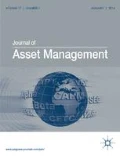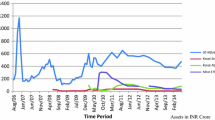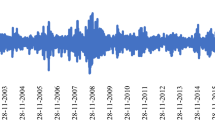Abstract
Exchange-traded Funds (ETFs) have been gaining increasing popularity in the investment community, as evidenced by their high growth both in the number of ETFs created and their net assets since 2000. As ETFs are in nature similar to index mutual funds, in this article we examine whether this growing demand for ETFs can be explained through their outperformance as compared with index mutual funds. We consider the population of all ETFs with inception dates before 2002 and then for each ETF found all the passive index mutual funds that had the same investment style as the selected ETF and had an inception date before 2002. This led to a sample of 230 paired matches for all the styles. Within each investment style we matched every ETF with all the passive index funds in that investment style and compared the performances of the matched pairs in terms of Sharpe Ratios and risk-adjusted buy and hold total returns for the period 2002–2010. We then applied the Wilcoxon signed rank test to examine whether ETFs had better performances than index mutual funds during the sample period. We conducted the test both within each style and for all the styles put together. In terms of Sharpe Ratio, out of the 12 styles included in the sample, for 5 styles the conclusion was that ETFs outperformed index funds, for 3 of the styles US Broad market, US large cap growth and US Reits index funds outperformed ETFs, and for 4 styles there was statistically no significant difference between ETFs and index fund performances. Out of the 230 paired matches of all the styles, ETFs outperformed index mutual funds 134 times in terms of Sharpe Ratio; however, the test of the hypothesis showed no statistically significant difference between ETFs and index fund performances in terms of Sharpe Ratio. The break-down of the results for risk-adjusted buy and hold total returns was slightly different from those for the Sharpe Ratio, though the overall conclusion was the same. For five of the styles, index funds outperformed ETFs, for three styles ETFs outperformed index funds, and for four styles there was statistically no significant difference between the performances of the two. Out of the 230 paired matches of all the styles put together, ETFs outperformed index mutual funds 125 times in terms of risk-adjusted buy and hold total return; however, the test of hypothesis showed no statistically significant difference between ETFs and index fund performances in terms of risk-adjusted buy and hold total return. These findings indicate that there is statistically no significant difference between ETFs and passive index mutual fund performances at the fund level, and that investors’ choice between the two is related to product characteristics and tax advantages.

Similar content being viewed by others
References
Aber, J.W., Li, D. and Can, L. (2009) Price volatility and tracking ability of ETFs. Journal of Asset Management 10 (4): 210–221.
Aczel, A.D. (2002) Complete Business Statistics. New York: McGraw-Hill Irwin.
Christie, S. (2005) Is the Sharpe Ratio useful in asset allocation? Applied Finance Center, Macquarie University, MAFC Research Papers 31 (1): 1–51.
Investment Company Institute. (2010) A review of trends and activity in the investment company industry. Investment Company Fact Book, http://www.icifactbook.org, accessed 17 May 2011.
Investment Company Institute. (2011) A review of trends and activity in the investment company industry. Investment Company Fact Book, http://www.icifactbook.org, accessed 17 May 2011.
Jobson, J. D. and Korkie, B. (1981) Performance hypothesis testing with the Sharpe and Treynor measures. Journal of Finance 36 (4): 889–908.
Johnson, W.F. (2008) Tracking errors of exchange traded funds. Journal of Asset Management 10 (4): 253–262.
Kostovetsky, L (2003) Index mutual funds and exchange-traded funds: A comparison of two methods of passive investment. The Journal of Portfolio Management 29 (4): 80–92.
Lo, A.W. (2002) The statistics of Sharpe ratios. Financial Analyst Journal 58 (4): 36–52.
Memmel, C. (2003) Performance hypothesis testing with the Sharpe ratio. Finance Letters 1 (1): 21–23.
Rompotis, G.G. (2009a) Interfamily competition on index tracking: The case of the vanguard ETFs and index funds. Journal of Asset Management 10 (4): 263–278.
Rompotis, G.G. (2009b) Performance and trading characteristics of iShares: An evaluation. The Icfa Journal of Applied Finance 15 (7): 24–39.
Sharpe, W.F. (1966) Mutual fund performance part 2, supplement on security prices. Journal of Business 31 (1): 119–138.
Sharpe, W.F. (1994) The Sharpe ratio. Journal of Portfolio Management 21 (1): 49–59.
Sharpe, W.F. (2007) The expected utility asset allocation. Financial Analyst Journal 93 (5): 18–30.
Author information
Authors and Affiliations
Corresponding author
Additional information
1has a PhD degree in finance from Walden University, an MPhil degree in management science from the University of Oxford and a joint honors BSc degree in mathematics, statistics and economics from the University of Salford. He holds the charted financial analyst and the certified financial risk manager designations. He is currently an Adjunct Faculty at Walden University mentoring PhD students and the Director of Research at Alpha Beta Investment Research LLC.
2has an MPhil degree in economics from the University of Oxford and a BSc degree in economics from Tehran University. She is currently an Adjunct Faculty at Straryer University and a Chief Economist at Alpha Beta Investment Research LLC.
Appendix
Rights and permissions
About this article
Cite this article
Sharifzadeh, M., Hojat, S. An analytical performance comparison of exchange-traded funds with index funds: 2002–2010. J Asset Manag 13, 196–209 (2012). https://doi.org/10.1057/jam.2012.3
Received:
Revised:
Published:
Issue Date:
DOI: https://doi.org/10.1057/jam.2012.3




